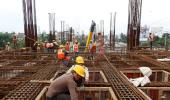The growth is particularly remarkable because it comes at levels higher than during the pre-Covid times, notes Mahesh Vyas.

CMIE's Consumer Pyramids Household Survey (CPHS) data suggests a significant increase in employment among industrial workers during the recent past.
These are salaried employees who work as industrial workers, typically in a factory.
The data does not include daily wage labourers who could be working in factories, but it includes contract labour.
It includes salaried workers on the shop-floor and instructors, plant operators, assemblers and assembly line operators, mill workers, mine workers, industrial machine operators and industrial equipment operators.
People working on ports or docks are also classified as industrial workers.
These are relatively good quality jobs and it is, therefore, particularly heartening to see an increase in their count in recent times.
We use the detailed break-up of employment by the nature of occupation in CPHS to locate this rising trend.
The frequency of measurement is a four-month period called a wave during which the complete CPHS sample of over 178,600 households is surveyed.
Data from such a complete survey allows estimations at a level of granularity that is not possible with the monthly CPHS sample, which is much smaller at about 44,500 households.
The latest CPHS Wave was administered during January-April 2022.
Data from this suggests that industrial workers increased by 4.4 per cent over the preceding wave that was administered during September-December 2021.
This was on top of an 11 per cent increase in industrial workers in the September-December 2021 wave.
These are significant increases in employment.
Besides, the growth in the last two waves is particularly remarkable because it comes at levels higher than during the pre-Covid times.
Employment of industrial workers had peaked in January-April 2019 -- more than a year before the Covid-induced lockdown brought the Indian economy to its knees.
The peak employment was 19.4 million in the January-April 2019 wave.
After this, a small but steady decline in employment in industrial workers set in.
In May-August 2019, employment fell to 19.2 million and then to 19.1 million in September-December 2019.
The next CPHS Wave was during January-April 2020 that was partly affected by the first lockdown.
During this wave, employment of industrial workers dropped to 18.7 million.
The full impact of the lockdown was seen in the wave of May-August 2020 when industrial workers lost nearly a quarter of their employment.
Employment fell to 14.2 million during the May-August 2020 wave. This was 5.2 million short of its peak level in January-April 2019.
Most of the recovery took place during the following two waves.
By May-August 2021, employment of industrial workers climbed back to 18.4 million.
In the next wave, September-December 2021 employment of industrial workers jumped up sharply to reach 20.5 million.
This was a million more than the earlier peak of 19.4 million industrial workers.
Employment among industrial workers increased further by about a million in the January-April 2022 wave. It reached 21.4 million. This is 2 million more than the peak employment.
It is instructive to benchmark the CPHS employment estimates with other estimates.
We first compare the employment estimates and then the growth rates to get a sense of the estimates presented above.
The 21.4 million industrial worker jobs seen in the CPHS database include those in the organised and unorganised sectors.
For comparison, the count of industrial workers in the organised sector as seen in the official Annual Survey of Industries was 12.8 million in 2018-2019 (the latest year for which such information is available).
During the same year, according to CPHS, industrial workers across organised and unorganised sectors added up to 18.1 million.
Prima facie, this implies that the unorganised sector absorbed about 5.3 million salaried industrial workers in 2018-19.
Industrial sector jobs are more than just salaried industrial workers.
They also include some managers, white-collar workers and daily-wage labourers.
During January-April 2022, according to CPHS, the industrial sector employed a total of 99.6 million.
Therefore, salaried industrial workers account for only 21.5 per cent of the total employment in industry.
But, this low share is because about 60 per cent of employment in the industrial sector is in construction activities. This employs mostly daily-wage labourers.
The growth in salaried industrial workers we see is more of a reflection of the growth in non-construction-related industrial activities -- manufacturing, mining and utilities.
These are also broadly the same constituents as in the official Index of Industrial Production (IIP). But, the IIP is largely restricted to the organised sector, while CPHS spans across organised and unorganised sectors.
The statistical correlation between the Wave-wise sequential growth in employment in industrial workers as seen in CPHS and the corresponding growth in the IIP is positive and works out to a moderate 0.48.
With a one-observation lag, it works out to a much better 0.64. This correlation has been derived using data since 2018.
A comparison of the annual growth rates in IIP and CPHS-derived employment in salaried industrial employment indicates that the latter is more volatile.
The IIP posted an 11.4 per cent growth in 2021-22.
The roughly corresponding growth in employment in industrial workers was more than twice that at 24.4 per cent.
In 2020-2021, while the IIP had fallen by 8.5 per cent, employment of salaried industrial workers had declined far more sharply by 16 per cent.
Prima facie, this suggests that the unorganised industrial sector witnessed a sharper fall in 2020-2021 and a correspondingly sharper recovery in 2021-2022.
But, both datasets suggest a robust recovery in the industrial sector in 2021-22.




Mahesh Vyas is MD & CEO, CMIE P Ltd.
Feature Presentation: Rajesh Alva/Rediff.com











